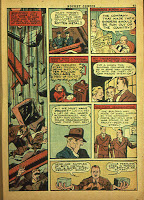 Story featured in this entry:
Story featured in this entry:Funny Pages #34 (Vol. 4 #1) Jan 1940 - Mantoka Maker of Indian Magic!
Early in his career, Jack Cole did a lot of work for a company loosely known as Centaur. In 1940, he wrote and drew two stories under the pen name "Richard Bruce," featuring an all-powerful Indian shaman called MANTOKA.
The first of the two stories, from Funny Pages #34 (January 1940) is presented here. The second story appeared three issues later, in Funny Pages #37 (April 1940). If anyone out there has scans of this story, please send and we'll post them on this blog!
The current issue of Roy Thomas' excellent comics fanzine, Alter Ego (#85, May 2009) features the first part of a detailed study of Centaur comics, including some great reproductions and information about Jack Cole and his contemporaries. I reccomend it. You can order it here. See also issue 25, which is dedicated to Jack Cole (and fandom giant Jerry Bails).The author of the Centaur survey, Lee Boyette, called Cole's MANTOKA series "crude, but engaging." I agree.
The art and story feel hastily composed. However, there are some nice touches, such as the dynamically laid-out title box, with the fun lettering. One can imagine Jack Cole sitting down to create this story from scratch, and revving himself up with this amazingly lively title splash.
The strong horizontal image of Mantoka holding the snake of knowledge is wonderfully set off by the tilted red rectangle behind him. The snake's rattle shakes just outside the framing rectangle, emphasizing it's power. The text dovetails perfectly into this layout, with the title of the exclamation point perfectly directing the eye down to the next panel below. Nice job, Jack!
Also of interest is page 4, panel 5... in which Manatoka pre-figures Plastic Man by zooming headfirst out of a cave.
All the slap-dash aside, we in are Cole territory. Manatoka gets his powers from a bite of the "snake of knowledge." He turns evil men into rats, and in the story's end, opens the earth into a vast canyon to swallow up yet more evilness. This is one guy you don't mess around with!






















